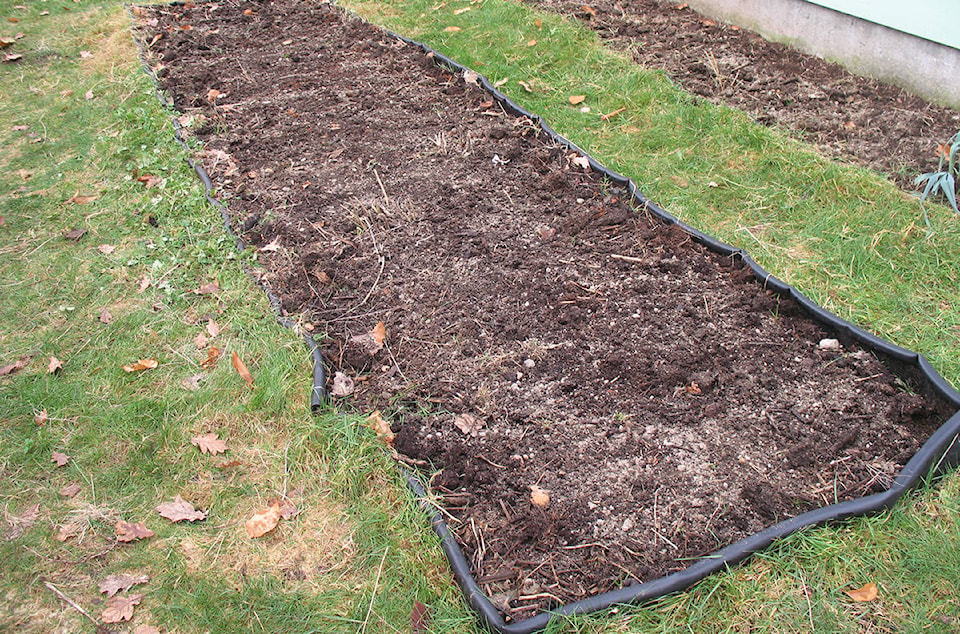By Mary Lowther
When I first met David he showed me around his lovely house and his equally lovely back yard. A beautiful, grassy backyard just crying out for vegetable beds, so I mentioned that I could grow some tasty asparagus in his yard and he said, “We should get married.”
Who knew he’d like asparagus almost as much as chocolate? That was in Victoria, 21 years ago and now my thoughts turn to the Mesachie asparagus bed. David has been slogging along most of the winter cutting down trees, wielding his new chainsaw and pulling out stumps from land across the street that we hope to farm in a couple of years, and I have been guiltily keeping the fire going, finding important things to do inside, but now that the rain has eased up it’s time to address the garden!
I like to surprise David with the first few spears of asparagus in spring. He chomps them down with grunts of pleasure and thinks I’m brilliant — at least he lets me think he thinks that.
To ensure his continued loyalty, I’m learning how to help these delicious spears sprout every spring. Male asparagus, we are told, out produce females by about three to one so we ought to spend a little more for all-male hybrids like Jersey Knight or Larac. These are sold as root stock or crowns and should be planted in deep soil with a pH of 7, not acidic. Set each crown in a trench eight inches deep in rows three feet apart. Lightly cover the crowns with soil and fill in the trench as the shoots grow. Cultivate the soil, spread one quater inch of compost over the bed and sprinkle fertilizer with lime at the rate recommended on the package. I use Solomon’s recipe that contains lime at the rate of four quarts per hundred square feet. Each spring I hoe out the weeds and add the same amounts of compost and fertilizer.
We are supposed to reef out the female plants when we see them setting seed and replace them with males because the latter are so prolific, but if you’re going to make sure these are males, you might as well have spent the extra in the first place and gotten the hybrids. I didn’t.
I bought the cheaper Mary Washingtons and when the females went to seed I let the seeds grow where they fell. Once they were large enough to set seed themselves, I yanked out the females and transplanted the males into the original empty spaces where the mothers had been. That was two years ago and now I think I’ve got two fairly decent, though small, beds happening for the price of one package of Mary Washington crowns.
When the spears start shooting up, check every day because they grow faster than Jack’s beanstalk!
Once the last of the decent-sized spears have been harvested, let the rest grow out into tall fronds to capture energy from the sun and store it in their roots for next year’s crop. During the dry summer, water them along with the rest of the garden to ensure continued root growth. I mulch the bed with straw to keep the soil cool and pull out weeds till mid fall. Then I pull off the mulch, toss this into the compost heap and cultivate the soil around the plants one last time.
I don’t leave mulch on any of my beds over the winter because I’ve found that slugs and wood bugs proliferate under the cozy canopy. Even with a mulch the rain washes nutrients out of the soil, so I prefer to sow most of my beds with cover crops that not only hold onto nutrients but add their own nutrients and biomass to the soil when I dig them under the following spring. I don’t use cover crop in the asparagus bed though because I think asparagus probably holds onto nutrients well enough.
Asparagus takes this bed out of commission permanently because it’s a perennial and since the harvest season spans only a month, one must consider how badly one wants to eat fresh, delicious, nutritious, home-grown asparagus. I considered this conundrum for about a nanosecond. Besides, if I stopped growing it David would accuse me of bait and switch.
Events: Mason Bee Free Seminar put on by the Community Garden. Feb. 28 at 1 p.m., 83 Lake Cowichan Rd., Lake Cowichan.
Please contact mary_lowther@yahoo.ca with questions and suggestions since I need all the help I can get.
